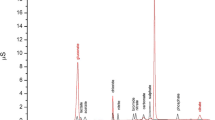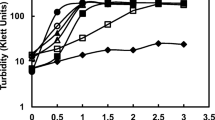Summary
A radiorespirometric technique was used to determine the effects of sodium N-methyldithiocarbamate (NaMDC) on uptake and oxidation of glucose by Fusarium oxysporum f. sp. lycopersici. The principal glucose oxidation pathway of the fungus was found to be the pentose cycle. Shifts to other oxidation pathways were not significant even when the fungus was treated with extremely high concentrations of NaMDC (5×10-2 M). Only when zinc ions were added to NaMDC solutions were shifts in pathway (and a drastic increase in toxicity) noted. The main effect of NaMDC was to delay the complete oxidation of glucose to CO2. In the concentration range between 0.5 to 10.0×10-2 M NaMDC dose response curves were bimodal with respect to spore germination, colony development, and CO2 production; with respect to glucose uptake the curves were unimodal. The bimodal dosage response curves could be divided into a first zone of inhibition, a zone of reversed toxicity, and a second zone of inhibition. Within the first zone of inhibition, colony development proved to be more sensitive to NaMDC than spore germination. In the zone of reversed toxicity the incorporation of carbon into the spores drops sharply, while in the second zone of inhibition a strong inhibition of glucose uptake is the dominating effect. It is indicated that NaMDC interfers with biosynthetic activities rather than enzymes of catabolic pathways.
Similar content being viewed by others
Abbreviations
- NaMDC:
-
Sodium N-methyldithiocarbamate
- NaDMDC:
-
Sodium dimethyldithiocarbamate
- TMTD:
-
Tetramethylthiuram disulfide, [=Bis(dimethylthiocarbamyl)disulfid, Thiram®]
- DMTD:
-
N,N′-dimethylthiuram disulfide [=Bis-(methylthiocarbamyl)disulfid]
- MIT:
-
Methylisothiocyanate
References
Bates, J. J., Tweedy, B. G.: Effect of thiram upon glucose metabolism by Fusarium oxysporum. Phytopathology 58, 1042 (1968).
Blumenthal, H. J.: Carbohydrate metabolism. In: G. C. Ainsworth, A. S. Sussman, The fungi, Vol. I, pp. 229–268. New York-London: Academic Press 1965.
David, I.: Azione del tetraetiltiuramdisolforo (T.T.D.) sul consumo di ossigeno, sulla glicolisi anaerobia e sul potere deidrogenasico del lievito di pane. Acta vitamin. (Milano) 4, 23–26 (1951).
Domsch, K. H., Corden, M. E.: Environmental influences on the sensitivity of Fusarium oxysporum f. sp. lycopersici to methylisothiocyanate. Phytopathology 60, 1347–1350 (1970).
Domsch, K. H., Corden, M. E.: Influence of copper and zinc ions on toxicity of sodium N-methyldithiocarbamate to Fusarium oxysporum f. sp. lycopersici. Arch. Mikrobiol. 88, 345–352 (1973).
Elson, J. E.: Fungitoxicity of sodium N-methyldithiocarbamate (Vapam) and its decomposition products. M. S. thesis, Oregon State University (1966).
Goksøyr, J.: The effect of some dithiocarbamyl compounds on the metabolism of fungi. Physiol. Plant. (Copenh.) 8, 719–835 (1955).
Goksøyr, J.: Chemical and fungicidal reactions of 3,5-dimethyl-tetrahydro-1,3,5-thiadiazine-2-thione (3.5 D). A comparison with sodium N-methyl-dithiocarbamate and methylisothiocyanate. Acta chem. scand. 18, 1341–1352 (1964).
Heath, E. C., Nasser, D., Koffler, H.: Biochemistry of filamentous fungi. III. Alternative routes for the breakdown of glucose by Fusarium lini. Arch. Biochem. Biophys. 64, 80–87 (1956).
Jeney, R., Zsolnai, T.: Die Hemmwirkung Chelatkomplex-bildender Verbindungen auf Vermehrung und Enzymtätigkeit von Saccharomyces cerevisiae. Zbl. Bakt., II. Abt. 110, 634–658 (1957).
Kaars Sijpesteijn, A. L., van der Kerk, G. J. M.: Investigations on organic fungicides. X. Pyruvic acid accumulation and its relation to the phenomenon of inversion growth as effected by sodium dimethyldithiocarbamate. Biochim. biophys. Acta (Amst.) 19, 280–288 (1956).
Morehart, A. L., Crossan, D. F.: Studies on the ethylene-bisthiocarbamate fungicides. Univ. of Delaware. Agr. exp. Stat. Bull. 357 (1965).
Owens, R. G.: Effects of elementary sulfur, dithiocarbamates, and related fungicides on organic acid metabolism of fungus spores. Develop. Ind. Microbiol. 1, 187–205 (1960).
Owens, R. G.: Organic sulfur compounds. In: D. C. Torgeson, Fungicides, Vol. II, pp. 147–301. New York-London: Academic Press 1969.
Owens, R. G., Hayes, A. D.: Biochemical action of thiram and some dialkyl dithiocarbamates. Contrib. Boyce Thompson Inst. 22, 227–240 (1964).
Roe, J. H.: The determination of sugar in blood and spinal fluid with anthrone reagent. J. biol. Chem. 212, 335–342 (1955).
Sisler, H. D., Cox, C. E.: Effects of tetramethylthiuram disulfide on anaerobic breakdown of glucose by brewers' yeast. Amer. J. Bot. 42, 351–356 (1955).
Thorn, G. D., Ludwig, R. A.: The dithiocarbamates and related compounds. Amsterdam: Elsevier 1962.
Tweedy, B. G., Loeppky, C.: The use of 14C-labelled glucose, glucuronate, and acetate to study the effect of atrazine, simazine, and fluometuron on glucose metabolism in selected plant pathogenic fungi. Phytopathology 58, 1522–1531 (1968).
Wang, C. H.: Radiorespirometric methods. In: J. R. Norris and D. W. Ribbons: Methods in microbiology, Vol. 6B pp. 185–230. New York-London: Academic Press 1972.
Wedding, R. T., Kendrick, J. B.: Toxicity of N-methyl-dithiocarbamate and methyl-isothiocyanate to Rhizoctonia solani. Phytopathology 49, 557–561 (1959).
Author information
Authors and Affiliations
Rights and permissions
About this article
Cite this article
Domsch, K.H., Corden, M.E. Investigations on the mode of action of sodium N-methyldithiocarbamate in Fusarium oxysporum f. sp. lycopersici . Archiv. Mikrobiol. 88, 353–363 (1973). https://doi.org/10.1007/BF00409946
Received:
Issue Date:
DOI: https://doi.org/10.1007/BF00409946




